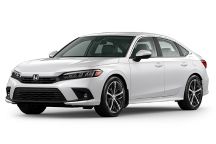
I left Malaysia in 2014 and have been living in Melbourne, Australia ever since. Some time around March 2017, I placed an order for a X253 GLC43. It was an easy decision to make – great amounts of cargo space, good rear seat space and legroom, decent power and great value for money. I didn’t consider any other car because the Audi SQ5 in Australia was diesel-powered, the BMW X3 was already aging, the Volvo XC60 didn’t have enough cylinders and the Porsche Macan GTS was too small. I also did not test drive any cars, including the GLC prior to the purchase, simply because I was already dead-set on buying one due to the lack of alternatives.
Owing to how I wanted the car to be specified to my liking, it took over 6 months for the car to be finally delivered from Bremen, Germany. The Australian GLC43 was already very highly specced, with these standard features that were absent from Malaysian models:
- Full safety package – Level 2 autonomy incorporating:
- Distronic Plus radar cruise control with active steering
- Lane assist with active steering intervention
- Active blind spot assist
- AEB with cross-traffic support and pedestrian braking
- Active engine hood for pedestrian protection
- Pre-Safe Plus with rear collision detection and mitigation
- Seat heating for driver and passenger
- Faux carbon fiber/aluminum trim combination
- Rear side airbags (yes, believe it or not, Malaysian GLC43s do not have rear side airbags, only rear curtain airbags).
- Automatic front passenger airbag deactivation (Malaysian models do not have this, so do NOT put a child seat in the front passenger seat. Otherwise, if the passenger airbag deploys, the airbag will slam into the child seat and injure the child)
- Rear seat-belt status indicator
- Rear privacy glass
Real-time traffic information (RDS-TMC)

Other than that, the rest of the standard equipment list is identical to Malaysian GLC43s. However, I specced my car to my liking, adding even more equipment and upgrading standard-fit items:
- Air-Balance perfume atomizer and ionization package
- Seat climate control – with heating and ventilation
- Digital TV tuner
- Genuine leather seats (replacing the standard artificial leather/Dinamica microfibre combination)
- Open-pore ash wood trim (replacing the standard faux carbon fiber/aluminum trim combination)
- Acoustic comfort package with acoustic windshield glass and windows
Deletion of red-colored seat belts


Buying Process
After walking into the dealership and selecting the spec that I wanted, the final build totaled up to around AUD 125,000 including taxes and other on-road costs (this happens to be pretty much the highest in all of Australia, because Victoria charges higher state stamp duties compared to other states). I haggled down the price to slightly under AUD 110,000 by paying cash in full. My primary reason for doing so was because car loan interest rates here can be around 7% or higher.
Having paid up, I next went to VicRoads (the state’s JPJ) and ordered a set of custom Warner Bros-themed vanity plates (incorporating the Road Runner from Wile E. Coyote and the Road Runner cartoon). The plates cost an extra $500.
Delivery Process and First Impressions
A few days before the delivery date, I rang up RACV Insurance and had my comprehensive policy arranged (which cost around $4000 a year for their no-questions asked policy, insured for an agreed value of $125,000). I originally wanted to go with Mercedes-Benz of Melbourne’s in-house insurance policy, but they refused to insure me as I was under 25 years old. They also refused to insure me as I did not have a local driving license, but were kind enough to recommend me to go with RACV instead (which is very reputable and well-regarded in Victoria).
On 10 October 2017, I headed to the dealership to pick up my car. Mercedes-Benz of Melbourne had already prepared my car and placed the customary red bow on the hood, with a full tank of 98-octane gasoline, Permagard aviation-grade paint protection and interior protection, along with the customary window tint.

My first impression when driving it out of the dealership was “wow, this air suspension is really soft and cushy”. It was basically like a magic carpet ride, right until I drove into a pothole (yup, they’re everywhere here too) and the 21-inch rims made themselves felt. Hard.
So much for the misconception that air suspension is the magic cure-all for bad roads. Tyre profile matters too.
Breaking in the Car and First Thoughts
I spent the next 1500km over the next 2 months to break in the car, never going above 4000rpm (I actually stayed below 3000rpm the whole time) and only driving in Eco or Comfort modes. I mainly used it in urban commutes, such as buying groceries from the market, running errands or heading to the park for exercise.


I really liked the build quality of the build interior – but then, no surprise there since it's built in Germany. No rattles or squeaks of any sort, and everything felt well-put together. The door cards didn't flex or squeak when pressed hard, trim pieces felt solid and soft touch materials were everywhere. The leatherette-wrapped dashboard and door sills were also a nice touch – lesser models are just left exposed with hard rubber.
Believe it or not, the 13-speaker 590W Burmester-branded sound system doesn't actually contain any Burmester parts. Burmester just did the audio tuning and put their brand on it - source link . While it definitely sounds way better than the base 5-speaker setup, the mids were lousy and the bass just sounded loose. Unfortunately, only the E-class and S-class can be specced with the 3D Burmester option (which is truly Burmester, but also very expensive).



The fuel consumption was horrendously bad, albeit unsurprising. I typically averaged around 27-30 L/100km in city driving with heavy traffic jams, and around 15-17 L/100km in urban driving. On highways, cruising at 80 typically yields around 9 L/100km.
Another thing I noticed was that automatic eco start-stop was extremely smooth. This was in big contrast to 4-cylinder Mercedeses, where the whole car would shake when the engine restarted, and the engine would run a little rough immediately after the restart. In Mercedeses with the M276 60º V6, I noticed that the start-stop process was very seamless, and the feeling of the engine starting was imperceptible, without any vibration whatsoever. I guess having a 60º bank angle helped, because that’s the magic figure for a V6 to be smooth without needing a balance shaft (as opposed to the older 90º V6s – M112 and M272).
Autonomous driving and how active safety saved my butt
Distronic Plus with active steering was really useful for long distance driving. Victorian speed limits are enforced very strictly (with only 1-2kph tolerance). As a result, I always engaged radar cruise control to always maintain an exact speed to avoid getting fined by cameras. Distronic Plus was also such that it would automatically maintain a set distance from any vehicles in front, and would also work in conjunction with active lane assist to autonomously steer the car to stay in lane (rather than just bouncing the car back and forth between lane markings). For long periods behind the wheel, having level 2 autonomous driving engaged takes a lot of strain off the driver, especially in traffic jams. I would just let Distronic Plus automatically stop and go in traffic, and steer itself in lane. Most people would feel tired and drained after spending long hours in traffic, but with the car pretty much driving by itself, never once have I felt tired after spending time in traffic.


In Malaysia, we have “mat rempit” and “basikal lajak”. In Melbourne, they are called terrorists on two wheels. More than a few times, active blind spot assist alerted me of cyclists approaching rapidly from behind my vehicle while I was making a left turn. For some reason, terrorists on two wheels love overtaking cars from the left. In the daytime, I can easily spot them coming from a long way away and would stop to let them pass before proceeding with my left turn. However, suburban Melbourne streets are typically unlit at night, and not all two-wheeled terrorists fit their bikes with headlights. Active blind spot assist has already saved me a few times from turning into the path of an unlit cyclist who didn’t have the sense to either overtake from the right or yield to turning vehicles.

There is also another type of driver – the “buta huruf” driver. I have had cross-traffic AEB intervene at 4-way junctions to prevent me from colliding with a car that failed to yield at a STOP sign. Most of my friends from Malaysia think that Australian drivers are generally more civilized, but I can safely assert that’s not the case.
And speaking of unlit roads – this was unexpected. Malaysian roads typically are very well-lit, with streetlamps on long stretches of motorways like the E6. Similar motorways in Victoria (and Australia in general) are typically unlit. As a result, the GLC’s adaptive matrix-beam LEDs activate far more often than the same car would back in Malaysia. Matrix beam headlights really work wonders – they high-beam every inch of the road, with cameras on top of the windscreen scanning roads for other vehicles and dynamically adjusting them to prevent blinding vehicles in front or oncoming vehicles. Not once have I been flashed by an oncoming vehicle to tell me to switch back to low beams. The effect is most clearly seen when following a vehicle in front – the headlights automatically adjust their beams to create a dark box around the vehicle in front, while maintaining high beams around it.
That being said, I’d hate to think the costs involved in replacing such headlights.

General Notes – Pros and Cons
To date (5 June 2020), I have only driven 10,987km in this car. This car is not my daily driver – hence the low mileage (I mostly drive an E220d All-Terrain estate wagon). However, I’ve spent enough time to know it inside out, and tell you why I don’t have any regrets.
Pro #1 – Great autonomous driving and active safety features
I think this one doesn’t need much explanation, as mentioned in previous paragraphs
Pro #2 – Decent amounts of power and superb ride comfort
Okay, so this car is much heavier than a C43 and handles like a whale compared to it, but I’ve never been left wanting for power. I’ve done 0-100 runs, timed with a VBOX and typically achieve 4.8-4.9 seconds (stock). When overtaking on rural roads, I usually complete the overtaking maneuver pretty fast and don’t spend much time in the opposite lane during the overtake. The air suspension really soaks up all the bumps, and it’s like riding on clouds. However, larger bumps or potholes easily make their presence felt, no thanks to the low-profile 21-inch wheels. Speed bumps also cause the car to wallow up and down after clearing it.

#Pro 3 – Ventilated seats are a godsend in summer
Australian summers are notoriously hot – it can sometimes reach as high as 45ºC. It easily feels hotter than Malaysia even at 35ºC and it’s like walking in a blast furnace when outside – because of our dry conditions and low humidity. Having ventilated seats keeps my butt cool during the summer, and prevents sweat patches from forming up on my back while glued to the seat.

#4 Insanely Practical


I think I'll let the pictures speak for themselves.
Oh, and the rear seats had more legroom than my E-class wagon. I guess I shouldn’t be surprised though, because the seat mounting points are mounted higher off the floor, which also translates to more legroom. Long distance drives are far more comfortable in the GLC for both front and backseaters compared to the E.
Pro #5 – a design that still looks fresh today



The GLC came at a time where the competition was already aging at (the X3 was in its F25 facelift, the Q5 was still in its first generation – albeit facelifted). As a result, its looks have held up pretty well, even with the facelifted one already available.
Con #1 – one of the worst infotainment systems on the planet
Audi MMI and BMW iDrive easily run circles around COMAND, which look like it existed when dinosaurs still roamed the planet. Even with the upgraded COMAND Online infotainment system, it’s really clunky to use.

Frequently-used functions always require many clicks and diving into sub-menus to locate, the online functionalities are a joke (extremely slow internet speeds over Bluetooth to the point that the built-in online apps are unusable) and text input using the touchpad is only suitable for left-handed people. And even worse, there is no CarPlay/Android Auto support (when even the base Audio 20 system from 2H 2017 onwards have it). Fortunately, there are people in Melbourne who are able to retrofit CarPlay/Android Auto without removing any of the original hardware – but it does come at a cost.
The only saving grace is that the voice commands actually work quite well, and address input using voice is generally quite fast and accurate (this functionality is only available in countries where the map’s language matches the system’s language). Maps are updated by the dealer at annual servicing, and live traffic information (such as traffic density, road closures, roadworks, etc.) is provided over RDS-TMC by every state’s JPJ.

Locations of fixed cameras are openly available, and it was just a matter of finding the right file in the right format for the infotainment system to read. The navigation system warns me with a soft ping whenever I’m 10 seconds away from a camera.
Con #2 – big turning circle and crabbing issues at full steering lock
No surprise there, given that the GLC is all-wheel drive. However, a car of this price range shouldn’t exhibit awful tyre crabbing. Crabbing only happens under cold weather (typically under 10ºC) with summer tyres and wet road surfaces whenever I apply full steering lock to make U-turns or maneuver into a parking space. Under these conditions, the tyres harden and skip across the surface. It’s embarassing when I have passengers in my car – they’d wonder what’s the awful grinding sound while I’m at full steering lock. This problem was solved by switching to softer winter tyres during late autumn/early winter.
The big turning circle sometimes made it hard for me to parallel-park into a tight space. Even with 360º cameras, it would still take plenty of back-and-forth before squeezing in successfully.

Con #3 – lousy fuel consumption
I really shouldn't complain about this, because I knew what I was signing up for when I bought a nearly 2000kg SUV with a twin turbo 3.0 V6. I've gotten used to seeing 15 L/100km figures on typical drives. Based on typical driving conditions, one full tank of gas won't last me 400km. Note – I only refuel with 98-octane gasoline.

Con #4 – a transmission that can’t make up its mind
The transmission is like the Malaysian government – it has a tendency to pick a gear, and then U-turn its decision a split second later. This problem is quite visible at medium speeds (around 60 kph, near the shift point between gears 6 and 7). Fortunately, this problem is only restricted to Eco and Comfort driving modes, and in any case, full manual override is available (it’ll actually let you rev up to the redline without shifting up).

Final thoughts
Would I have bought something else if it was available? Actually…yes. If the GLC 350d (V6 diesel) was available at that time, that’s what I would have bought instead. I don’t drive my car hard and rarely push it to the redline, so having torque lower down the rev range is far more useful for me.
But do I regret my purchase? Not really – my family’s history with Mercedeses is long enough for me to know the typical quirks and workarounds to get around them (yet another not-so-subtle dig at the prehistoric COMAND infotainment). I’d say that every dollar I coughed up for it is well-spent – it has never let me down with its space, comfort, build quality, refinement, versatility and most importantly, its safety. If I could only pick one car to keep out of all my others, I’d pick this one (although my heart would ache at having to put a lot more kilometers into it). I could practically live out of this car in an RV park on long road trips, because I can easily fold down the back seats into a bed (placing a mattress pad over it) and still sit up in it without my head touching the roof. I can’t do that in my estate wagon.
Would I buy this car in Malaysia? Definitely not – because even with the CKD version, it’s overpriced given the spec available there.
Given the direction Mercedes is heading, their future does look promising – especially with the new MBUX infotainment system and all. They’ve finally wised up and completely revamped everything wrong with COMAND. Although it may not be as polished as iDrive, MBUX is nearly as good and it looks to be future-proofed, with support for OTA updates. I’m also very attracted by their new compact lineup, especially the GLB’s packaging, interior design and build quality. Their current compact lineup has designs and build quality that easily rival or outstrip previous-generation E classes. And if they are already doing such wonders to their MFA2 platform vehicles, I can only imagine how much better the next iteration of the GLC will get.










